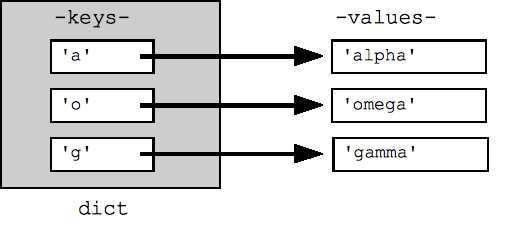Dict Hash Table
Python's efficient key/value hash table structure is called a "dict". The contents of a dict can be written as a series of key:value pairs within braces { }, e.g. dict = {key1:value1, key2:value2, ... }. The "empty dict" is just an empty pair of curly braces {}.
Looking up or setting a value in a dict uses square brackets, e.g. dict['foo'] looks up the value under the key 'foo'. Strings, numbers, and tuples work as keys, and any type can be a value. Other types may or may not work correctly as keys (strings and tuples work cleanly since they are immutable). Looking up a value which is not in the dict throws a KeyError -- use "in" to check if the key is in the dict, or use dict.get(key) which returns the value or None if the key is not present (or get(key, not-found) allows you to specify what value to return in the not-found case).
## Can build up a dict by starting with the the empty dict {}
## and storing key/value pairs into the dict like this:
## dict[key] = value-for-that-key
dict = {}
dict['a'] = 'alpha'
dict['g'] = 'gamma'
dict['o'] = 'omega'
print dict ## {'a': 'alpha', 'o': 'omega', 'g': 'gamma'}
print dict['a'] ## Simple lookup, returns 'alpha'
dict['a'] = 6 ## Put new key/value into dict
'a' in dict ## True
## print dict['z'] ## Throws KeyError
if 'z' in dict: print dict['z'] ## Avoid KeyError
print dict.get('z') ## None (instead of KeyError)

A for loop on a dictionary iterates over its keys by default. The keys will appear in an arbitrary order. The methods dict.keys() and dict.values() return lists of the keys or values explicitly. There's also an items() which returns a list of (key, value) tuples, which is the most efficient way to examine all the key value data in the dictionary. All of these lists can be passed to the sorted() function.
## By default, iterating over a dict iterates over its keys.
## Note that the keys are in a random order.
for key in dict: print key
## prints a g o
## Exactly the same as above
for key in dict.keys(): print key
## Get the .keys() list:
print dict.keys() ## ['a', 'o', 'g']
## Likewise, there's a .values() list of values
print dict.values() ## ['alpha', 'omega', 'gamma']
## Common case -- loop over the keys in sorted order,
## accessing each key/value
for key in sorted(dict.keys()):
print key, dict[key]
## .items() is the dict expressed as (key, value) tuples
print dict.items() ## [('a', 'alpha'), ('o', 'omega'), ('g', 'gamma')]
## This loop syntax accesses the whole dict by looping
## over the .items() tuple list, accessing one (key, value)
## pair on each iteration.
for k, v in dict.items(): print k, '>', v
## a > alpha o > omega g > gamma
There are "iter" variants of these methods called iterkeys(), itervalues() and iteritems() which avoid the cost of constructing the whole list -- a performance win if the data is huge. However, I generally prefer the plain keys() and values() methods with their sensible names. In Python 3000 revision, the need for the iterkeys() variants is going away.
Strategy note: from a performance point of view, the dictionary is one of your greatest tools, and you should use where you can as an easy way to organize data. For example, you might read a log file where each line begins with an ip address, and store the data into a dict using the ip address as the key, and the list of lines where it appears as the value. Once you've read in the whole file, you can look up any ip address and instantly see its list of lines. The dictionary takes in scattered data and make it into something coherent.
Dict Formatting
The % operator works conveniently to substitute values from a dict into a string by name:
hash = {}
hash['word'] = 'garfield'
hash['count'] = 42
s = 'I want %(count)d copies of %(word)s' % hash # %d for int, %s for string
# 'I want 42 copies of garfield'
























 2334
2334

 被折叠的 条评论
为什么被折叠?
被折叠的 条评论
为什么被折叠?








